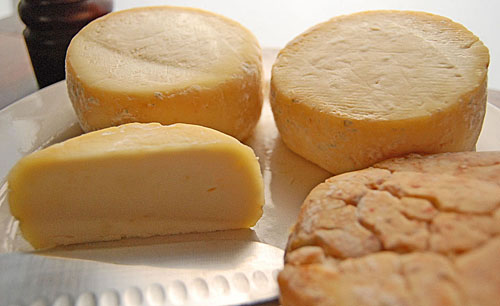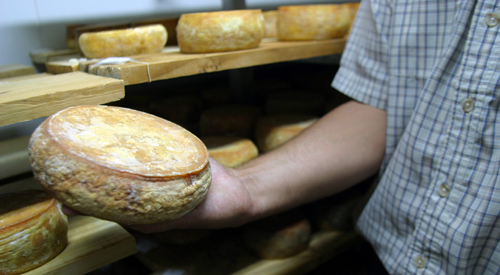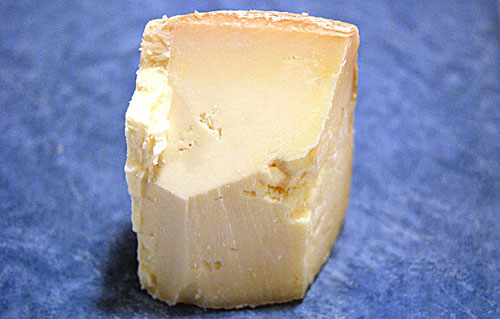Wine and Cheese. Queso y vino. Le Vin et Fromage. Two peas in a pod. Quite possibly the end all, be all of wine pairing combos. In US tastings and our Culinary Santiago tour, I field the question quite a bit about what wines best accompany cheese, another great fermented phenomenon. It seems to be a little bit of a mystery.
Let’s have a look. Both wine and cheese are made from natural ingredients, milk and grapes, that are transformed by fermentation from its raw materials with bacteria and yeast, respectively. What results is something that takes a life of its own and is inherently unpredictable. Wine, and cheese, can be funky, stinky, gamey, fruity, and beg the question, what the heck do these have in common with their original ingredients?
To illustrate this, wineries can “choose” selected yeast to highlight a specific characteristic they want to bring to a wine like aromas in Pinot Noir or a toasty note in sparkling wine. Similarly, with cheese they choose the strain of bacteria that will cause the milk (which only varies by animal such as cow, sheep, or goat) to take on those qualities from a Havarti to the pungent Stilton Blue, which has strains of penicillin causing its blue veins.
Another similarity is the aging process. Both cheeses and wines range from being fresh (milky or fruity) to mature. The vessel used and the duration affects both the wine and the cheese. For example, think of the difference between a wine made in stainless steel tanks versus oak during fermentation. Then, the differences between an unaged and unoaked wine with one that is aged for years in French oak. With cheese, the base difference begins with whether or not the milk is pasteurized (i.e. “cooked”). Unfortunately, many of the cheeses today are pasteurized by law. Cheese purists (me included) agree that modern pasteurizations wipe out all bacteria, good and potentially hazardous, effectively wiping out those positive bacteria that make the cheese taste so darn amazing. One of the other factors that affect cheese as a final product is whether or not it’s washed, has a natural rind, is coated, has flavor added to it in the form of spices or herbs. There are a million variables to play with.
Since on our tours here in Chile and Argentina we visit various artisan cheesemakers, the pursuit of cheese has converted into a full-on passion for me. Here are some tips to guide you into incorporating cheese with your South American wine appreciation. Make friends with your cheese monger or local expert at some of the amazingly well stocked stores found throughout the US. From tiny cheese shops in your hometown to even bigger chains like Whole Foods to Central Market, Wegman’s and Eli’s in New York. I guarantee that pairing South American wines with these cheeses will take the region’s wines to new astronomical levels of flavor bliss.
Tip 1: Serve the cheeses in order of intensity, from less to more.
That’s to say, taste the cheeses from fresh to mature cheeses. Hosting a cheese and wine party? Start with fresh cheeses like queso fresco, available in many Latin markets, which is made daily in many homes from full fat cow’s milk with cuajo, bacteria they sell at pharmacies. Next, try mild yet gooey cow’s milk cheeses like camembert or brie. We currently are seeing a move in national production in the south of Chile from Valdivia with decent results. After, move into those cheeses made from goat’s milk like chevre or crotin. Finally, step into the nutty, deep-flavored sheep’s milk and pungent family of blue cheeses, the most stinky and delicious of all.
Tip 2: The whiter the cheese, the more fresh and fruity the wine
While this is a pretty broadstroke kind of tip, since we saw the similarities of how wine and cheese are made, it makes sense. If you pull out a gung ho, muscular Cabernet and pair it with a fresh mozzarella, I guarantee the wine is going to 1-2-3 that poor cheese.
So let’s get some specific recommendations in here. If you’re eating some feta or buffalo mozzarella, stick to whiter wines, pair with a zesty Sauvignon Blanc from Chile’s San Antonio Valley like Casa Marin Los Cipreses. Want something red? No problema, think young and fruity like a dry Malbec rosé from Susana Balbo’s Crios, or her spice-laden yet light-bodied Bonarda.
As you get darker, or yellower in color, the signs of aging in cheese, take it up a notch. How about a Vermont aged Cheddar with a wild, earthy cool-climate Syrah like or Kingston’s Bayo Oscuro from Casablanca? Or maybe a Brebis with a velvety aged (yum, try 2007 vintage) Carmenere from Cachapoal in Chile like Terrunyo, or a balanced, rich Merlot from Argentina’s Patagonia like Infinitus or Noemia.
Love blue cheese? So do I. It drives me loca. Crazy. Dreams of Stilton, Maytag, and Danish blue top my fantasies as does a good Roquefort. While local blues have left me cold, thankfully, for all you cheese lovers in Chile, we now have La Fromagerie, which imports primo cheeses from France—right to your doorstep. Classic combos? Well, if money is no object, then break out the Sauternes but if not, try a local Late Harvest like Morandé. I also love blues with big, young Cabernet (aerate and decant first please) or a punchy Malbec like Mauricio Lorca’s Poético.
Let’s not overlook Sheep’s Milk cheeses, which have exploded onto the local scene from the coast vineyards to San Antonio. When in Santiago, do procure at Coquinaria, the basement of the W hotel, Matetic Vineyard’s torta de Rosario, made from raw sheep’s milk. Gooey and funky like a Brie when new it ages and hardens into a Manchego over 6-8 months and is more addictive than crack. Be warned it will smell up your kitchen and/or frig, so the best solution is just to eat it—fast. Trust me, that won’t be a problem. Honestly, I have yet to find a wine not complemented by miraculous sheep’s milk cheese. There’s something about the acidity of the milk, its inherent nuttiness and gaminess, the deepness of flavor. Pair it with complex blends, ideally aged. Oh this would go so well with the likes of Chile’s creme de la creme Almaviva, the super suave Malbec Fabre Montmayou’s Gran Vin from Mendoza, or Bodega Carrau’s Amat Tannat from Uruguay.
And well, then there’s champagne and the sparklers that go well with everything. That’s right, everything and anything. But if you really want to spark nirvana between your lips, just try it with some of that nutty, above-mentioned Manchego or sheep’s milk cheese from Patagonia. Suggestions? By all means, start with Cruzat.
Tip 3: Look at the Cheese context
As a final note, rather than dissecting cheeses apart by category or milk type, I think it is appropriate to look at them holistically when it comes to pairing, just like wines. What’s the context? Is this an aperitivo? Cheese course? Nibble? Quick dinner? Are the guests (or myself!) conservative in flavors or adventurous? Just think about the combinations a little and the occasion. Cheese and Wine are appropriate in a salad for dinner or as a cheese board at a party. Heck, why not make them the center of attention for the party or include them as a classic cheese course or dessert (which I will take that any day over cake)?
Hungry yet? Dive into the wine and cheese pairings with South American wines. You’ll see they were made for each other, all thanks to wonderful Madre Naturaleza. The pureness, intensity, depth, and energy behind the wines will light up with these fantastic cheeses. Que disfruten.
















